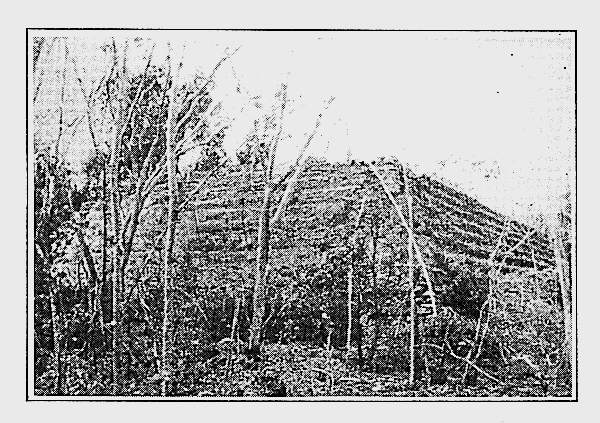Gympie Pyramid: Difference between revisions
(photo) |
No edit summary |
||
| Line 1: | Line 1: | ||
<div><ul> | <div><ul> | ||
| Line 5: | Line 6: | ||
=Origin= | =Origin= | ||
The Gympie Pyramid was supposedly discovered in 1975 by pseudoarchaeologist Rex Gilroy. Rex Gilroy visited several locations with ruins and odd rock formations throughout Australia. On of these such ruins near Queensland, Australia Gilroy asserts is actually a part of a pyramid built by the Egyptians or the Phoneticians. This is an extremely diffusionist view of early history. Gilroy wrote a book on this subject entitled the ''Pyramids of the Pacific''. There are only a few of the original structures that survive, the rest, including the pyramid, now only exist in photographs. Meaning that properly trained archaeologists can not got to the site to see if the claims made by Gilroy are in fact verifiable. Furthermore, Grlroy has claimed to find Phonetician inscriptions all around Australia. The inscriptions all have deeply flawed syntax that clearly indicates the inscriptions are fakes. <ref name="Newbrook">Newbrook, Mark. "Zheng He in the Americas and Other Unlikely Tales of Exploration and Discovery." Skeptical Inquirer (2016).</ref> | |||
More recently a local author, Brett Green, has taken over for Gilroy in his investigation of the site. Brett Green, though more critical than Gilroy, is still not a trained archaeologist and is not critical enough to make his evidence valid. Green claims to have artifacts that suggest Asian and European occupation. Moreover, he claims that local indigenous language is similar to ancient Mediterranean and Indian languages. This is based largely on superficial, impressionistic comparisons. His complete lack of formal training in linguistics makes him entirely unfit to make these sort of comparisons. Moreover, nearby is a site called Sarina, which is said to be a phonetician port by Val Osborn. While Osborn appears to be a more scholarly source, some of her claims are still quite eccentric.<ref name="Newbrook">Newbrook, Mark. "Zheng He in the Americas and Other Unlikely Tales of Exploration and Discovery." Skeptical Inquirer (2016).</ref> | |||
=Pseudoarchaeological Impact= | |||
=Scientific Disproof= | =Scientific Disproof= | ||
= | The so called Gympie Pyramid is likely instead the remains of a 19th century vineyard terracing.<ref name="Newbrook">Newbrook, Mark. "Zheng He in the Americas and Other Unlikely Tales of Exploration and Discovery." Skeptical Inquirer (2016).</ref> | ||
=Sources= | =Sources= | ||
<references /> | |||
Green, Brett. Gympie Pyramid. 2004, The Dhanurian Society. Accessed 30 Nov. 2017. | Green, Brett. Gympie Pyramid. 2004, The Dhanurian Society. Accessed 30 Nov. 2017. | ||
Revision as of 15:52, 1 December 2017
Origin
The Gympie Pyramid was supposedly discovered in 1975 by pseudoarchaeologist Rex Gilroy. Rex Gilroy visited several locations with ruins and odd rock formations throughout Australia. On of these such ruins near Queensland, Australia Gilroy asserts is actually a part of a pyramid built by the Egyptians or the Phoneticians. This is an extremely diffusionist view of early history. Gilroy wrote a book on this subject entitled the Pyramids of the Pacific. There are only a few of the original structures that survive, the rest, including the pyramid, now only exist in photographs. Meaning that properly trained archaeologists can not got to the site to see if the claims made by Gilroy are in fact verifiable. Furthermore, Grlroy has claimed to find Phonetician inscriptions all around Australia. The inscriptions all have deeply flawed syntax that clearly indicates the inscriptions are fakes. [1]
More recently a local author, Brett Green, has taken over for Gilroy in his investigation of the site. Brett Green, though more critical than Gilroy, is still not a trained archaeologist and is not critical enough to make his evidence valid. Green claims to have artifacts that suggest Asian and European occupation. Moreover, he claims that local indigenous language is similar to ancient Mediterranean and Indian languages. This is based largely on superficial, impressionistic comparisons. His complete lack of formal training in linguistics makes him entirely unfit to make these sort of comparisons. Moreover, nearby is a site called Sarina, which is said to be a phonetician port by Val Osborn. While Osborn appears to be a more scholarly source, some of her claims are still quite eccentric.[1]
Pseudoarchaeological Impact
Scientific Disproof
The so called Gympie Pyramid is likely instead the remains of a 19th century vineyard terracing.[1]
Sources
Green, Brett. Gympie Pyramid. 2004, The Dhanurian Society. Accessed 30 Nov. 2017.
